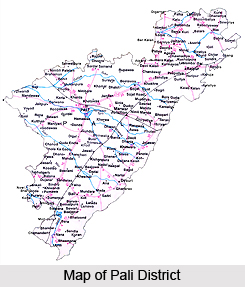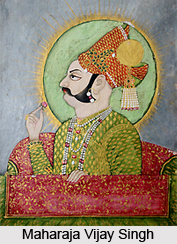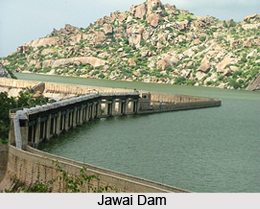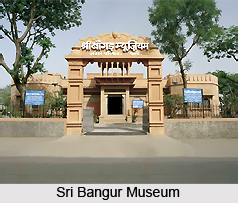 Pali with its glorious historical back ground, traces its origin right back to the age of the Mahabharata. It is said to have been a part of baalla desh, a democratic state of the then Arbuda province. The legendary Chinese traveller Huen-Tsang in his memoirs mentions that Pali, in 667 A.D., was part of then Gurjar Desh and was administered by local bodies. Before the formation of Rajasthan Pali was the part of erstwhile Marwar state. The district as it exists today is linked to the surrounding districts by means of the Aravalli hills. The district is far approaching its goal of complete literacy, by means of various educational programs undertaken to implement the same. Discussed below is a basic outline of the district of Pali.
Pali with its glorious historical back ground, traces its origin right back to the age of the Mahabharata. It is said to have been a part of baalla desh, a democratic state of the then Arbuda province. The legendary Chinese traveller Huen-Tsang in his memoirs mentions that Pali, in 667 A.D., was part of then Gurjar Desh and was administered by local bodies. Before the formation of Rajasthan Pali was the part of erstwhile Marwar state. The district as it exists today is linked to the surrounding districts by means of the Aravalli hills. The district is far approaching its goal of complete literacy, by means of various educational programs undertaken to implement the same. Discussed below is a basic outline of the district of Pali.
Location of Pali District
Pali district extends its boundaries in the south-west from the Ajmer district to the Sirohi district. In the north-east it is bounded by the Nagaur district. The district is located between the north latitudes of 24.45 degrees and 26.75 degrees, and between the east longitudes of 72.48 degrees to 74.20 degrees. The entire district stands surrounded by Jalore district, Sirohi district, Udaipur district, Rajasamand district, Ajmer district and Nagour district. Pali district covers a total area of 12,387 Sq. kms. National Highway No. 14 links Pali from Delhi in North to Ahmedabad in South.
History of Pali district
 Pali with its glorious historical back ground traces its origins in the Mahabharata age from `baalla desh`, a democratics` state of the then Arbuda province. The legendary Chinese traveller Huen-Tsang in his memoirs mentions that Pali, in 667 A.D., was part of then Gurjar Desh and was administered by local bodies. Geologists trace the existence of Pali to the pre-historic age, and hold that it has emerged from the vast western sea spread over a large part of the present day Rajasthan. The area was ruled by the King Harshavardhana of the Chalukya dynasty till about the end of the 7th century. Rajput rulers from all over India started focussing their reigns in this area after the Arab invasion of Sind. During the period from 10th to 15th century, the boundaries of Pali extended to adjoining Mewar, Godwad and Marwar. All Rajput rulers resisted the foreign invaders but individually fought for each other`s land and leadership. 16th and 17th century saw a number of battles in the surrounding areas of Pali. By then Pali had become subservient to the Rathores of Marwar state. Pali was rehabilitated by Maharaja Vijay Singh and soon it became an important commercial centre. Under British rule Pali played an important role by pioneering the freedom struggle in Marwar. Various Thakurs of Pali under the stewardship of Thakur of Auwa, who was the most powerful of all, confronted the British rule. Before the formation of Rajasthan Pali was a part of erstwhile Marwar state.
Pali with its glorious historical back ground traces its origins in the Mahabharata age from `baalla desh`, a democratics` state of the then Arbuda province. The legendary Chinese traveller Huen-Tsang in his memoirs mentions that Pali, in 667 A.D., was part of then Gurjar Desh and was administered by local bodies. Geologists trace the existence of Pali to the pre-historic age, and hold that it has emerged from the vast western sea spread over a large part of the present day Rajasthan. The area was ruled by the King Harshavardhana of the Chalukya dynasty till about the end of the 7th century. Rajput rulers from all over India started focussing their reigns in this area after the Arab invasion of Sind. During the period from 10th to 15th century, the boundaries of Pali extended to adjoining Mewar, Godwad and Marwar. All Rajput rulers resisted the foreign invaders but individually fought for each other`s land and leadership. 16th and 17th century saw a number of battles in the surrounding areas of Pali. By then Pali had become subservient to the Rathores of Marwar state. Pali was rehabilitated by Maharaja Vijay Singh and soon it became an important commercial centre. Under British rule Pali played an important role by pioneering the freedom struggle in Marwar. Various Thakurs of Pali under the stewardship of Thakur of Auwa, who was the most powerful of all, confronted the British rule. Before the formation of Rajasthan Pali was a part of erstwhile Marwar state.
Geography of Pali District
The plains of the district are located 180 to 500 meters above sea level, whereas Pali city the district headquarters is situated at 212 meters above sea level. The Great Aravali hills link Pali district with Ajmer, Rajsamand, Udaipur and Sirohi Districts. The highest point of the Aravalli hills in the district measures 1099 metres. Among the important rivers flowing in the district are the Luni River, and its tributaries, the Jawai, Mithadi, Sukadi, Bandi and Guhiabala. The Largest dams of this area Jawai Dam and Sardar Samand Dam are also located in Pali district. The climatic conditions in the district are different from western Rajasthan. During summer time, the highest temperature rises upto 46-47 degree Celsius during peak time in May-June.
 A large variation in temperature is found due to adjoining green and hilly areas. Winters are moderately cool during December-January, lowering the mercury to 4-5 degree Celsius occasionally. Average rainfall in the district during the months of July-October is 300 mm.
A large variation in temperature is found due to adjoining green and hilly areas. Winters are moderately cool during December-January, lowering the mercury to 4-5 degree Celsius occasionally. Average rainfall in the district during the months of July-October is 300 mm.
Education in Pali District
According to census report 2001, Pali district records the literacy rate of 54.92 percent of the total population. While male literacy percentage is 73.06, the female literacy is fast gaining success over its earlier figures. Census 2001 reports 36.70 percent literacy in female population. Pali district is fast approaching its goal of `Complete Literacy` through its various literacy programmes viz complete literacy campaign 1994, Post literacy campaign 1996, Continuing education programme of National Literacy Mission etc. Pali district has also been awarded `Satyen Matriya` award for its achievement during complete literacy campaign 1994. Besides this programmes, formal education is imparted through the institutions of Primary, Upper primary, Secondary and Higher education level.
Economy of Pali District
Agricultural activities of Pali district are mostly dependent on monsoon. Although the district has a lot of irrigation dams, ponds etc., yet more then 50 percent of the farmers are dependent on monsoon. Most of the farmers obtain two crops i.e. Kharif and Rabi. Rabi crops are usually sown in November whereas Kharif crops are sown with the beginning of the first rains in July. Kharif crops include bajra, jowar, moong, rice, groundnut, red chillies etc. Pali is famous for its textile industries. Cotton and synthetic clothes and yarn were exported to other states of India at a very cheap rate.
 Some new industries have also been developed like marble cutting, marble finishing etc. One of the biggest composite textile mills of India ` Maharaja Shri Umaid mills` (Estd. in the year 1940) is also situated at Pali. Main production of this mill is cotton, Hank yarn etc. which is used for preparing different cloths. Besides this, many more industries are situated at different areas of Pali district i.e. lather based industries, agriculture instruments, chemical based, cement industry, minerals based units like stone crashers etc.
Some new industries have also been developed like marble cutting, marble finishing etc. One of the biggest composite textile mills of India ` Maharaja Shri Umaid mills` (Estd. in the year 1940) is also situated at Pali. Main production of this mill is cotton, Hank yarn etc. which is used for preparing different cloths. Besides this, many more industries are situated at different areas of Pali district i.e. lather based industries, agriculture instruments, chemical based, cement industry, minerals based units like stone crashers etc.
Tourism in Pali District
Pali district has a lot to offer the tourists. Located here are a number of beautiful temples, such as the Parshuram Mahadev Temple, Ranakpur Jain Temples etc.Apart from the many places of pilgrimage tourism located here, there are also a number of places where one can go for leisure, such as gardens and beautiful dams. Prime among the various places of leisure tourism is the Sri Bangur museum here, which has many historically significant exhibits on display.






